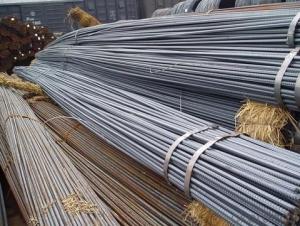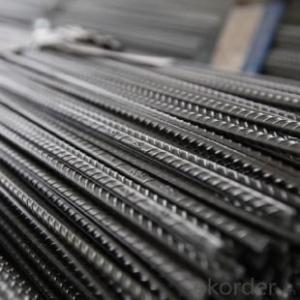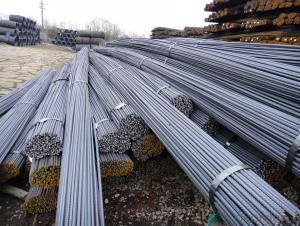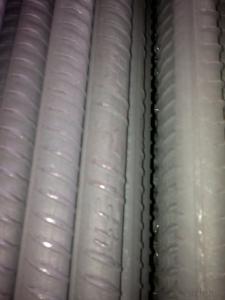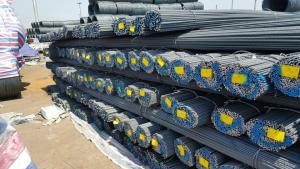GB Standard HRB400 Steel Deformed Bar 14mm/16mm
- Loading Port:
- Tianjin
- Payment Terms:
- TT or LC
- Min Order Qty:
- 25 m.t
- Supply Capability:
- 20000 m.t/month
OKorder Service Pledge
OKorder Financial Service
You Might Also Like
GB Standard HRB400 Steel Deformed Bar 14mm/16mm
Description:
-Standard: GB
-Material: HRB400
-Specification:
| Diameter(mm) | Section Area(mm2) | Mass(Kg/m) | Length(m) |
| 14 | 153.9 | 1.21 | 9, 12 or as customs' request |
| 16 | 201.1 | 1.58 | 9, 12 or as customs' request |
Chemical Composition(%) of GB Standard HRB400 Steel Deformed Bar 14mm/16mm:
| C | Mn | Si | S | P | V |
| ≤0.25 | ≤1.60 | ≤0.08 | ≤0.045 | ≤0.045 | 0.04-0.12 |
Mechanical Properties of GB Standard HRB400 Steel Deformed Bar 14mm/16mm:
Yield Strength (N/cm²) | Tensile Strength (N/cm²) | Elongation (%) |
≥400 | ≥570 | ≥14 |
Usage and Applications of GB Standard HRB400 Steel Deformed Bar 14mm/16mm:
Deformed bar is widely used in buildings, bridges, roads and other engineering construction. Big to highways, railways, bridges, culverts, tunnels, public facilities such as flood control, dam, small to housing construction, beam, column, wall and the foundation of the plate, deformed bar is an integral structure material. With the development of world economy and the vigorous development of infrastructure construction, real estate, the demand for deformed bar will be larger and larger.
Packaging & Delivery of GB Standard HRB400 Steel Deformed Bar 14mm/16mm:
Packaging Detail: products are packed in bundle and then shipped by container or bulk vessel, deformed bar is usually naked strapping delivery, when storing, please pay attention to moisture proof. The performance of rust will produce adverse effect.
Each bundle weight: 2-3MT, or as required
Payment term: TT or L/C
Delivery Detail: within 45 days after received advanced payment or LC.
Label: to be specified by customer, generally, each bundle has 1-2 labels
Trade terms: FOB, CFR, CIF
Images of GB Standard HRB400 Steel Deformed Bar 14mm/16mm:
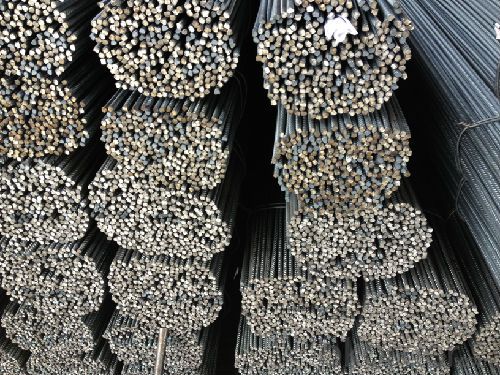
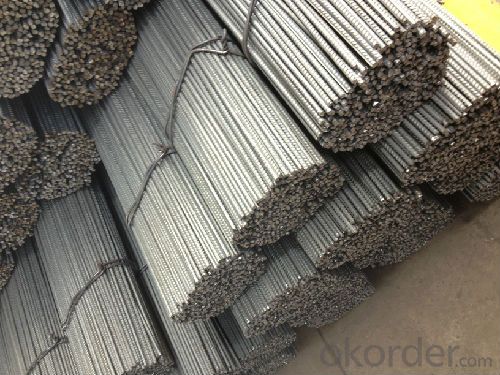
*If you would like to get our price, please inform us the size, standard/material and quantity. Thank you very much for your attention.
- Q: Are thread steels of coarse steel?
- Thread steel does not belong to coarse steel, rough is shaped steel, fine is wire.
- Q: How do steel rebars affect the overall durability of marine structures?
- Steel rebars play a crucial role in enhancing the overall durability of marine structures. Due to their high tensile strength and corrosion resistance, steel rebars provide structural stability and prevent the degradation of marine structures caused by environmental factors such as saltwater, waves, and harsh weather conditions. One of the main challenges faced by marine structures is corrosion, as the constant exposure to saltwater can significantly weaken the structure over time. Steel rebars, often coated with anti-corrosive materials such as epoxy or galvanized coatings, act as a protective layer against corrosion. This coating prevents the penetration of saltwater and other corrosive agents, ensuring the longevity of the marine structure. Furthermore, steel rebars are known for their high tensile strength, which allows them to withstand the tremendous forces exerted by waves and currents. These rebars provide the necessary reinforcement to the concrete used in marine structures, preventing cracks or failure due to excessive loads. This reinforcement enhances the structural integrity of the marine structure, making it more resilient against external forces. Moreover, steel rebars offer flexibility in design and construction, allowing for the creation of complex and robust marine structures. With the ability to bend and shape rebars as needed, engineers can design structures that are better suited to withstand the unique challenges posed by the marine environment. This flexibility also facilitates the construction process, making it more efficient and cost-effective. Overall, steel rebars significantly contribute to the durability of marine structures by providing corrosion resistance, enhancing structural stability, and enabling innovative design solutions. Their presence ensures the longevity and reliability of marine structures, allowing them to withstand the harsh conditions of the marine environment for extended periods.
- Q: What are the guidelines for the proper spacing of steel rebars in beams?
- The guidelines for the proper spacing of steel rebars in beams are determined by engineering standards and codes. These guidelines ensure the structural integrity and strength of the beam. Here are some general guidelines to consider: 1. Rebar spacing: The spacing between rebars should be such that it allows for proper concrete placement and consolidation. Typically, the spacing is measured in terms of rebar diameter or as a percentage of the beam depth. The specific spacing requirements may vary based on factors such as the beam size, load requirements, and design specifications. 2. Minimum and maximum spacing: There are usually minimum and maximum spacing requirements for rebars in beams. The minimum spacing ensures proper concrete cover around the rebar to protect it from corrosion and provide fire resistance. The maximum spacing helps in distributing the loads evenly and prevents excessive cracking of the concrete. 3. Concrete cover: The rebars should be adequately covered by concrete to provide protection against corrosion and provide fire resistance. The concrete cover is the distance between the outer surface of the rebar and the edge of the beam. The required concrete cover is specified in engineering codes and is based on factors such as exposure conditions, durability requirements, and fire ratings. 4. Spacing around supports and openings: Special attention should be given to the spacing of rebars around supports such as columns and walls, as well as around openings like doorways or windows. These areas may experience higher stresses and require additional reinforcement. Engineering codes provide specific requirements for these situations, taking into account the size and shape of the supports or openings. 5. Lateral and longitudinal reinforcement: In addition to the spacing of rebars along the length of the beam (longitudinal reinforcement), beams may require additional reinforcement in the form of stirrups or ties (lateral reinforcement). These elements provide resistance against shear forces and help in preventing diagonal cracking. The spacing and size of these additional reinforcement elements are determined based on the design requirements and load conditions. It is important to note that the specific guidelines for spacing of steel rebars in beams may vary depending on regional building codes, project specifications, and engineering standards. Therefore, it is crucial to consult with a qualified structural engineer or refer to the applicable building codes and design documents for accurate and up-to-date guidelines.
- Q: Can steel rebars be used in offshore platform construction?
- Yes, steel rebars can be used in offshore platform construction. They are commonly used as reinforcement in concrete structures, providing strength and durability to withstand the harsh offshore environment and support the weight and loads of the platform.
- Q: Are there any disadvantages to using steel rebars?
- Yes, there are some disadvantages to using steel rebars. Firstly, steel rebars can corrode over time, especially in environments with high moisture or exposure to chemicals, which can reduce their strength and durability. Additionally, steel rebars are susceptible to thermal expansion and contraction, leading to cracking in concrete structures. Moreover, steel rebars are heavy and can be challenging to handle and transport, making construction processes more labor-intensive.
- Q: Are steel rebars suitable for reinforcement in theme parks and amusement centers?
- Yes, steel rebars are suitable for reinforcement in theme parks and amusement centers. Steel rebars offer high strength and durability, making them ideal for heavily loaded structures and areas with high foot traffic. They can effectively enhance the structural integrity and ensure the safety of buildings and rides in theme parks and amusement centers.
- Q: What is the fatigue strength of steel rebars?
- The fatigue strength of steel rebars refers to their ability to withstand repeated loading and unloading cycles without experiencing failure or fatigue crack propagation. This strength can vary depending on factors such as the specific grade of steel, rebar size and shape, surface condition, and loading conditions. Generally, steel rebars have high fatigue strength due to their inherent toughness and ductility, making them suitable for applications in construction projects where cyclic loading is common, such as bridges, highways, and buildings.
- Q: Can steel rebars be used in swimming pools and water tanks?
- Swimming pools and water tanks can indeed utilize steel rebars. These structures often rely on steel rebars for added strength and stability. During construction, the rebars are typically inserted into the concrete or masonry walls of the pool or tank. Notably, steel rebars possess exceptional durability and corrosion resistance, rendering them an optimal choice for these applications which entail constant exposure to water. Furthermore, the incorporation of steel rebars aids in averting cracks and enhancing the overall structural integrity of the pool or tank.
- Q: What are the common factors that can cause premature failure of steel rebars?
- There are several common factors that can cause premature failure of steel rebars. These include corrosion, improper installation, inadequate concrete cover, poor quality control during manufacturing, exposure to extreme temperatures, high levels of stress or loading, and environmental factors such as chemicals or moisture.
- Q: How do steel rebars distribute loads in concrete structures?
- Steel rebars distribute loads in concrete structures by providing reinforcement and increasing the tensile strength of the concrete. When loads are applied to the structure, the rebars help to evenly distribute the forces throughout the concrete, preventing cracks and failure. The rebars act as a framework or skeleton within the concrete, effectively transferring the load and enhancing the overall structural integrity of the concrete structure.
Send your message to us
GB Standard HRB400 Steel Deformed Bar 14mm/16mm
- Loading Port:
- Tianjin
- Payment Terms:
- TT or LC
- Min Order Qty:
- 25 m.t
- Supply Capability:
- 20000 m.t/month
OKorder Service Pledge
OKorder Financial Service
Similar products
Hot products
Hot Searches
Related keywords
